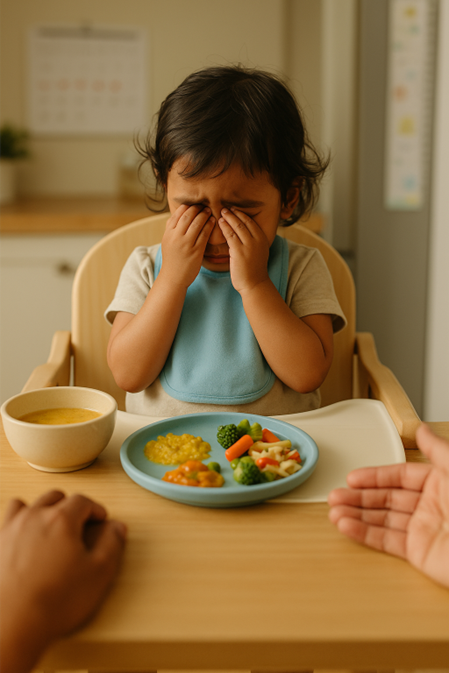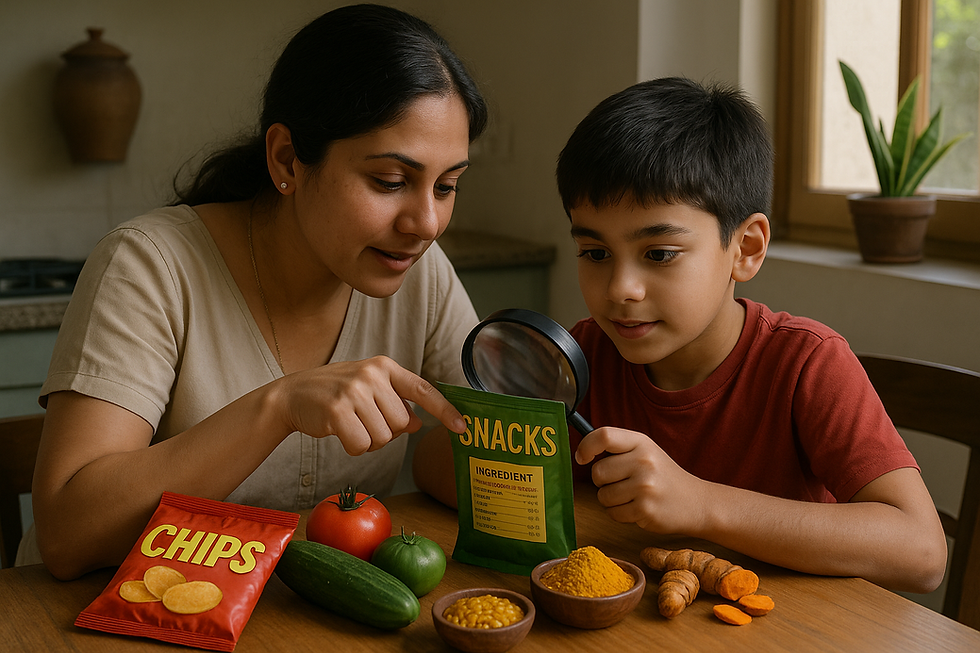The Great Broccoli Negotiation: Why Toddlers Refuse Food
- Dr Tejal Risbud Rao

- Aug 1
- 5 min read

You've lovingly prepared a baby bowl of dal, a soft chapati, and some perfectly cooked bhindi. You place it in front of your toddler with hope in your heart. Their response? They seal their lips like Fort Knox and slowly shake their head. f you've ever seen your toddler refuse food for no apparent reason, you're not alone.
This is portion overwhelm where kids face what looks like a small, nutritious meal to us and respond with the diplomatic grace of a seasoned negotiator.
As a pediatrician (and parent who's been through this exact scenario), let me walk you through what's really happening in your child's mind and share some practical strategies that actually work.
What Is Portion Overwhelm in Toddlers?
Here's the clinical truth: Portion overwhelm happens when a child's perception of "too much food" doesn't align with what adults consider "just right."
The parenting reality? You plate some rajma, and suddenly your kitchen turns into the United Nations – complete with silent protests and diplomatic immunity claims.
This isn't your child being difficult. It's a completely normal part of their development, and understanding it can transform your mealtimes from battlegrounds into peaceful negotiations.
Why Toddlers Refuse Food: The Real Reasons
Kids See the World Differently
To your toddler, one small bowl of khichdi might genuinely feel like climbing Mount Everest, especially if there's anything green lurking in there. If you’ve ever wondered why a toddler refuse food even when they seem hungry, here's what's really going on:
Size perception is different: What looks tiny to you feels enormous to them
Small stomachs, big expectations: Their actual stomach is about the size of their fist
Visual overwhelm kicks in: Multiple foods on one plate can feel chaotic
Appetite Changes Like the Weather
Here's something that might surprise you: your child's appetite isn't meant to be predictable. Growing children's nutritional needs fluctuate constantly:
Growth spurts create hunger waves: Some days, they eat like tiny lumberjacks
Activity levels affect appetite: Playground days vs. quiet indoor days look very different
Mood influences eating: Just like adults, emotions impact their desire for food
Developmental phases play a role: Learning new skills can temporarily suppress appetite
The Power of "No" Equals Growing Independence
When your child refuses food, they're not just being stubborn. Those zipped lips and strategic chair scooting? That's your toddler practicing important life skills:
Testing boundaries safely: Food is a low-stakes way to assert independence
Developing personal preferences: They're figuring out what they actually like
Building decision-making muscles: Every "no" is practice for bigger choices later
Practical Solutions When Toddlers Refuse Food (Without the Drama)
Start Ridiculously Small
I mean it starts with portions that seem almost comically tiny. One spoon of dal, one bite of sabzi. If they want more, fantastic! If not, there's no plate panic or food waste guilt.
Pro tip from the pediatric trenches: Use the one tablespoon per year of age rule. A two-year-old gets two tablespoons of each dish. Simple, manageable, and surprisingly effective.
Master the Stage by Stage Approach

Instead of presenting the full meal at once, try offering small portions one item at a time. Serve the chapati first, then introduce the curry, followed by a little rice.
This approach feels less overwhelming to children and can actually make eating feel more like a fun discovery process than a daunting task.
Serving Strategy | How It Helps | Example |
Small portions | Reduces visual overwhelm | 1-2 tablespoons per dish |
Sequential serving | Makes eating feel manageable | Chapati first, then curry |
Child-led requests | Builds positive food associations | "More dal?" when they finish |
Give Them the "Power Pick"
Let your child make small choices about their food. Can they choose their favorite potato piece from the sabzi? Pick out the softest paneer cube? Select which vegetable to try first?
Empowered eaters are curious eaters. When children feel they have some control over their meal, they're much more likely to engage with the food positively.
Rebrand Like a Marketing Genius
Sometimes, a simple name change works wonders. Transform spinach into "Super Saag," dal becomes "Golden Power Soup," and carrot sticks turn into "Toothbrush Swords."
Is it silly? Absolutely. Does it work? You bet. Children respond beautifully to imagination and play, even at mealtime.
Respect the Quiet Refusal
Here's something many parents struggle with: when your child calmly says "no" and zips their mouth shut, that's actually good communication. No screaming, no tantrum just clear, peaceful boundary setting.
Respect this communication. Let them know it's okay not to eat, but also establish that meals have a reasonable timeframe. Try again at the next meal without making it a big deal.
What NOT to Do When Toddlers Refuse Food
Avoid these common traps that can make food refusal worse:
Don't bribe with sweets repeatedly: This teaches children that healthy food is something to endure rather than enjoy
Skip the guilt trips entirely: Saying "so much effort went into this food" puts unfair emotional pressure on your child
Avoid bite by bite pressure: Treating every spoonful like a nutrition exam creates negative food associations
Don't compare to other kids: "Look how well your cousin eats" never helps anyone
Stop the airplane games: Forcing fun when they're clearly done often backfires
Remember, the goal isn't winning individual mealtime battles. You're building long term healthy relationships with food not just securing temporary victories with aloo mutter.
When to Worry About Food Refusal in Toddlers

Most cases of food refusal are completely normal and resolve naturally as children grow. However, you should consult your pediatrician if you notice:
Consistent refusal patterns: They refuse all foods for several days straight
Physical changes: Weight loss or signs of nutritional deficiency appear
Family stress levels: Mealtimes are causing significant anxiety for everyone
Extreme food anxiety: Your child shows panic or fear around any food
Building Long-Term Success
The key to overcoming food refusal lies in patience and consistency. Here's your roadmap:
Stay calm during refusals: Your energy sets the tone for the entire meal
Keep offering variety: It can take 10+ exposures before kids try new foods
Model good eating habits: Children copy what they see, not what they hear
Trust their appetite cues: Kids are surprisingly good at self regulation when pressure is removed
Celebrate small wins: One bite of broccoli deserves the same recognition as finishing a full plate
Final Thoughts from a Pediatrician Who Gets It
If your child turns away from that lovingly crafted sabzi tonight, take a deep breath. This is normal, expected, and temporary. They're not rejecting your cooking or your love, they're learning autonomy and developing their own relationship with food.
Be patient with the process. Keep offering variety without turning it into a negotiation. Let them say "no no" in peace when they need to. And when no one's looking, feel free to enjoy that untouched bhindi sabzi yourself, you've definitely earned it.
Remember, you're not just feeding your child's body; you're nurturing their lifelong relationship with food, independence, and self-trust. That's worth more than any single meal.
Dr. Tejal Risbud Rao
Pediatrician and Veteran Negotiator of Mealtime Battles & Silent Standoffs
References
1. American Academy of Family Physicians. (2018). "Nutrition in Toddlers." American Family Physician, 98(4), 227-233.
2. Boundy, E. O., Boyd, A. F., Hamner, H. C., et al. (2020). "US Pediatrician Practices on Early Nutrition, Feeding, and Growth." Journal of Nutrition Education and Behavior, 52(1), 31-38.
3. Field, D., Garland, M., & Williams, K. (2003). "Correlates of specific childhood feeding problems." Journal of Paediatrics and Child Health, 39(4), 299-304.
4. Birch, L. L., & Fisher, J. O. (1998). "Development of eating behaviors among children and adolescents." Pediatrics, 101(3), 539-549.
5. Centers for Disease Control and Prevention. (2024). "Infant and Toddler Nutrition: How Much and How Often to Feed." Retrieved from https://www.cdc.gov/infant-toddler-nutrition/
6. American Academy of Pediatrics. (2023). "Toddler Food and Feeding Guidelines." Retrieved from https://www.aap.org/en/patient-care/healthy-active-living-for-families/toddler-food-and-feeding/





Comments